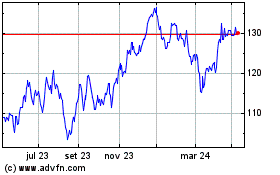By David Winning
SYDNEY-- Rio Tinto PLC's next leader will inherit a decision
that could define the miner's next decade: whether to partner with
China on a potentially lucrative but costly African project that
could reshape the iron-ore market.
That decision adds to a list of challenges for the successor to
Jean-Sébastien Jacques, who was forced out after Rio Tinto
destroyed two ancient rock shelters at Juukan Gorge in Australia in
May.
The iron ore buried in Guinea's Simandou mountains is among the
world's largest untapped deposits of the commodity. Its riches have
long been coveted by global miners and investors competing to
exploit booming demand for a commodity used to make steel.
Chinese companies are pushing hard to develop Simandou after a
consortium including a unit of aluminum maker China Hongqiao Group
Ltd. and port operator Yantai Port Group Co. secured rights to mine
the northern half of the deposit in a $14 billion tender late last
year. Rio Tinto and partners own the southern half, but they could
save billions of dollars in construction costs if they
collaborate.
Rio Tinto's decision boils down to whether it wants to be
involved in a project that could put pressure on iron-ore prices by
increasing global supply of the commodity. A 2014 study by the
company put the cost of developing the southern half of Simandou at
$20 billion. Political risk in West Africa is also high.
Still, Simandou's iron ore is likely too valuable to remain in
the ground. China consumes around one billion tons of the commodity
every year, mostly imports from Australia. A development in Guinea
would boost the security of China's supply, especially for
high-grade ore that is typically less polluting when turned into
steel.
"It's an awkward one for Rio Tinto," said Paul McTaggart, a
Sydney-based resources analyst at Citi. "It either participates in
the development of Simandou, and it puts pressure on iron-ore
prices, or it doesn't participate and they have an iron-ore asset
that's worth nothing."
Rio Tinto once saw Simandou as central to its ambitions to
become the world's top iron-ore producer after winning the rights
to mine a 300-square-mile area in 2006. But those plans soon
foundered in a country with few skilled workers and poor
infrastructure. Exporting the iron ore would have required spending
billions of dollars to build a cross-country rail line and a deep
water shipping port.
In 2008, Guinea's government stunned the mining industry by
telling Rio Tinto it wasn't moving fast enough at Simandou and
stripped the company of rights to develop 50% of the deposit. In
2016, Rio Tinto dismissed two executives for their alleged role in
making $10.5 million in payments to a consultant in Guinea.
Scarred by the experience, Rio Tinto tried to get out of
Simandou. But the company's plan to sell its interest to
joint-venture partner Aluminum Corp. of China, known as Chinalco,
fell apart in 2018 when the deal didn't complete.
"We have always assumed that Simandou would happen," Jakob
Stausholm, Rio Tinto's chief financial officer, said in an
interview. "It has always been in our long-term forecasts, and
depending on the price of iron ore, there's space for
Simandou."
To make a decision on Simandou, Rio Tinto's next chief executive
will need to assess how quickly China's demand for steel will peak
as that would influence the country's appetite for iron ore. The
availability of scrap metal could also weaken demand. How
Simandou's returns measure up against other options to grow
production, including via acquisitions, will be another factor.
The company will have to assess the impact that Simandou's
supply would have on iron-ore prices, as it risks making Rio
Tinto's existing operations in Australia and Canada less
profitable. Australia accounts for more than 50% of the world's
trade in iron ore by sea.
"Simandou represents a major threat to long-term iron-ore
prices," possibly reducing them by more than 10%, said Lyndon
Fagan, analyst at J.P. Morgan Securities Australia Ltd.
Rio Tinto last month began a search for a successor to Mr.
Jacques, who will remain in his role no later than March 31. Some
analysts expect an external candidate will be chosen, as many
potential leaders left the miner in the past four years. In
addition to deciding Simandou, the new leader will have to rebuild
the miner's reputation following the caves' destruction, deal with
regulatory investigations in the U.S. and Australia, and oversee
the delayed expansion of a copper mine in Mongolia.
The speed at which the group that owns the northern half of
Simandou, SMB-Winning Consortium, is moving ahead has surprised
industry watchers. In June, Guinea's government signed a basic
agreement with SMB-Winning for the development of Simandou,
including the need for a 400-mile railway through mountains and
across marshy lowlands to the coast.
Goldman Sachs expects the consortium to start the railway's
construction next year if it can secure financing, and begin
producing iron ore about four years later. That narrows the window
for Rio Tinto to decide whether to collaborate, with Goldman
estimating that infrastructure sharing could cut combined
construction costs by up to $7 billion and boost returns for each
project by more than 3%.
Rio Tinto has signaled it is open to discussions on
infrastructure sharing. The company is working with Chinalco and
other partners to find ways to lower costs and speed up development
of Simandou's southern half.
"We believe it makes economic sense to build an infrastructure
system that can be shared," said Bold Baatar, chief executive of
Rio Tinto's energy and minerals division.
Singapore-based Winning International Group, which leads the
SMB-Winning Consortium, declined to comment on whether it would be
open to collaborating with Rio Tinto.
Write to David Winning at david.winning@wsj.com
(END) Dow Jones Newswires
October 01, 2020 05:44 ET (09:44 GMT)
Copyright (c) 2020 Dow Jones & Company, Inc.
Rio Tinto (ASX:RIO)
Gráfico Histórico do Ativo
De Mar 2024 até Abr 2024

Rio Tinto (ASX:RIO)
Gráfico Histórico do Ativo
De Abr 2023 até Abr 2024
